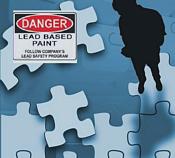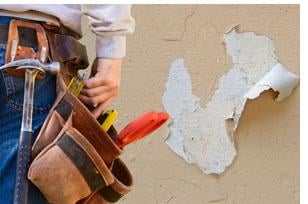Wisconsin DHS Has Approved LeadCheck Test Kits for RRP Use

According to a letter sent to 3M on Wednesday June 27, 2012 by the Bureau of Environmental and Occupational Health, the state of Wisconsin has just approved the use of 3M’s LeadCheck test kit for use under the state’s Lead Safe Renovation Rule. Wisconsin is one of the states that has taken over enforcement and administration of the RRP rule from EPA. They did so on April 22, 2010.
How and why it was approved
 After review of regulatory requirements and test kit performance measures the Wisconsin Department of Health Services has concluded that the 3M LeadCheck test kit can reliably determine that lead-based paint is not present on wood, ferrous metal (alloys that contain iron), drywall and plaster substrates.
After review of regulatory requirements and test kit performance measures the Wisconsin Department of Health Services has concluded that the 3M LeadCheck test kit can reliably determine that lead-based paint is not present on wood, ferrous metal (alloys that contain iron), drywall and plaster substrates.
According to the letter: “Therefore, immediately, the Department recognizes the 3M LeadCheck paint test kit for use in Wisconsin limited to the negative response criteria under s.DHS 163.16 (2) (a) when performed by certified lead-safe renovators following the manufacturer’s instructions.”
According to the letter the Department has determined that using the negative response criterion alone is as protective of human health and the environment because a false positive would require a renovator to follow the lead-safe renovations when they would not have been necessary and therefore would be overly protective rather than less protective of human health and the environment.
Still hoping for a reliable and affordable quantitative test kit

Still hoping for a test kit that meets both the negative and positive response criteria, the letter clarifies that this recognition will remain in place until such time a kit that does both becomes available. The current test kits are only accurate enough to determine whether lead is present or not (qualitative test), not indicate how much lead is present (qualitative).
EPA had assumed a reliable quantitative test kit would be available by September of 2012 when it wrote their RRP Rule, but no kits with that ability have been recognized by EPA or any other state program. According to EPA’s own research, the lack of a quantitative test kit has doubled the number of projects requiring lead-safe work practices, projects that otherwise would not have required those practices if a quantitative test kit were available. Read this RRPedia article for more clarification on this subject.
The Department plans to place Information about the new recognition on the lead program website and will provide information about the recognition to all Wisconsin training providers offering accredited lead-safe renovation courses. As of posting this blog the department’s website did not have information about the test kit recognition.
Update 7/11/12:
Information about the test kit recognition and approved method of use has been posted to the department's web site.
Guidelines for Wisconsin Renovators
For the benefit of those working on target housing and child occupied facilities in Wisconsin, the DHS offers the following guidance documents for those who must comply with the state’s Lead-Safe Renovation Rule.
Guidelines for Certified Abatement Workers and Supervisors
Guidelines for Renovation Contractors and Painters
Guidelines for Plumbers, HVAC, Fire Control
Guidelines for Rental Property Managers

 Looking for accurate information about the EPA RRP rule?
Looking for accurate information about the EPA RRP rule? 

 At 58:56 Mr. Tipton asks: “So, effectively what you are saying is if the EPA is asking for input maybe it would be a good idea if they listened? To that question Merrick replied that the EPA is always gracious about meeting with NARI and taking their input, but he further clarifies his response by commenting “They take our comments and disappear behind doors and we never hear from them again.”
At 58:56 Mr. Tipton asks: “So, effectively what you are saying is if the EPA is asking for input maybe it would be a good idea if they listened? To that question Merrick replied that the EPA is always gracious about meeting with NARI and taking their input, but he further clarifies his response by commenting “They take our comments and disappear behind doors and we never hear from them again.”

 Renovators and others hoping for the return of the opt-out still have reason for hope for the return of the RRP opt-out because of the Lead Exposure Amendments Act of 2012. Two separate bills were introduced in the Senate and House earlier this year by Sen. James Inhofe, R-Okla., and Reps. John Sullivan, R-Okla., and Tim Murphy, R-Pa. Learn about the most recent Amendment Act introduced on June 7th
Renovators and others hoping for the return of the opt-out still have reason for hope for the return of the RRP opt-out because of the Lead Exposure Amendments Act of 2012. Two separate bills were introduced in the Senate and House earlier this year by Sen. James Inhofe, R-Okla., and Reps. John Sullivan, R-Okla., and Tim Murphy, R-Pa. Learn about the most recent Amendment Act introduced on June 7th 
 NARI members are encouraged to send letters of support, using the NARI template you can find
NARI members are encouraged to send letters of support, using the NARI template you can find 
 The rule includes all painted or coated surfaces. So yes, the siding must be assumed to have lead until tested otherwise.
The rule includes all painted or coated surfaces. So yes, the siding must be assumed to have lead until tested otherwise. The work practices for exterior projects are based on a performance standard – if the activity disturbs a painted surface (generally, by creating paint chips or dust) in excess of 20 square feet, the work area must be contained so that dust or debris does not leave the work area while the renovation is being performed. In this case, if the removal of the aluminum siding results in the disturbance of paint in excess of 20 square feet, then the RRP Rule applies. However, if the removal activity could be performed in such a way that does not disturb 20 square feet of painted surface, then the RRP Rule would not apply.
The work practices for exterior projects are based on a performance standard – if the activity disturbs a painted surface (generally, by creating paint chips or dust) in excess of 20 square feet, the work area must be contained so that dust or debris does not leave the work area while the renovation is being performed. In this case, if the removal of the aluminum siding results in the disturbance of paint in excess of 20 square feet, then the RRP Rule applies. However, if the removal activity could be performed in such a way that does not disturb 20 square feet of painted surface, then the RRP Rule would not apply. Today, according to an
Today, according to an  Reinstate the opt-out provision to allow homeowners without small children or pregnant women residing in them to decide whether to require LRRP compliance, not the government.
Reinstate the opt-out provision to allow homeowners without small children or pregnant women residing in them to decide whether to require LRRP compliance, not the government.



 My advice to every remodeler is to find a company with an XRF that can do a test and produce a report that can be used as a tool to deal with lead above the regulatory limit. Get fluent in using LSWP. Check each other to make sure no one is poisoning their clients or their pets and lets be professional about it.
My advice to every remodeler is to find a company with an XRF that can do a test and produce a report that can be used as a tool to deal with lead above the regulatory limit. Get fluent in using LSWP. Check each other to make sure no one is poisoning their clients or their pets and lets be professional about it.
 Posted signs: These must be posted on all sides of the work area to define the work area, must be in the primary language of occupants, must be posted before the beginning of the renovation, and must remain until cleaning verification is achieved.
Posted signs: These must be posted on all sides of the work area to define the work area, must be in the primary language of occupants, must be posted before the beginning of the renovation, and must remain until cleaning verification is achieved. Remove or cover furniture/objects: Remove (preferred) objects like furniture, rugs, window coverings; or cover them with plastic sheeting with all seams and edges taped.
Remove or cover furniture/objects: Remove (preferred) objects like furniture, rugs, window coverings; or cover them with plastic sheeting with all seams and edges taped. Cover duct opening: Close and cover all HVAC vents in the work area with taped down plastic sheeting or other impermeable materials (e.g., magnetic covers).
Cover duct opening: Close and cover all HVAC vents in the work area with taped down plastic sheeting or other impermeable materials (e.g., magnetic covers).

 There have been some discussions where a particular contractor talks about how RRP is impossible to follow; only to find out the contractor has never done an RRP job … or even taken the course. Others talk about how they don’t need anyone to tell them how to clean up after a lead based paint project. Yet, they have never done a lead dust test to see if they really are cleaning up correctly. One contractor talked about how his employees were safe working around lead paint, but had never done air monitoring to see if it was true. Once, I had a contractor tell me I was doing risk assessment wrong. Yep … you guessed it. He never had done a risk assessment, taken a risk assessor course or even taken a lead safe work practice class of any type.
There have been some discussions where a particular contractor talks about how RRP is impossible to follow; only to find out the contractor has never done an RRP job … or even taken the course. Others talk about how they don’t need anyone to tell them how to clean up after a lead based paint project. Yet, they have never done a lead dust test to see if they really are cleaning up correctly. One contractor talked about how his employees were safe working around lead paint, but had never done air monitoring to see if it was true. Once, I had a contractor tell me I was doing risk assessment wrong. Yep … you guessed it. He never had done a risk assessment, taken a risk assessor course or even taken a lead safe work practice class of any type. The reality is an expert is someone who has education and experience in the subject being discussed. I like how Wikipedia states it … “experts have a prolonged or intense experience through practice and education in a particular field”.
The reality is an expert is someone who has education and experience in the subject being discussed. I like how Wikipedia states it … “experts have a prolonged or intense experience through practice and education in a particular field”. ST. PAUL, Minn. — 3M LeadCheck Swabs, the simple way to test for lead and assist in compliance with the Environmental Protection Agency’s (EPA) Renovation, Repair and Painting Rule (RRP), are now recognized by the EPA for use on drywall and plaster.
ST. PAUL, Minn. — 3M LeadCheck Swabs, the simple way to test for lead and assist in compliance with the Environmental Protection Agency’s (EPA) Renovation, Repair and Painting Rule (RRP), are now recognized by the EPA for use on drywall and plaster.


